I am trying to create a for loop which uses a defined function (B_lambda) and takes in values of wavelength and temperature to produce values of intensity. i.e. I want the loop to take the function B_lambda and to run through every value within my listed wavelength range for each temperature in the temperature list. Then I want to plot the results. I am not very good with the syntax and have tried many ways but nothing is producing what I need and I am mostly getting errors. I have no idea how to use a for loop to plot and all online sources that I have checked out have not helped me with using a defined function in a for loop. I will put my latest code that seems to have the least errors down below with the error message:
import matplotlib.pylab as plt
import numpy as np
from astropy import units as u
import scipy.constants
%matplotlib inline
#Importing constants to use.
h = scipy.constants.h
c = scipy.constants.c
k = scipy.constants.k
wavelengths= np.arange(1000,30000)*1.e-10
temperature=[3000,4000,5000,6000]
for lam in wavelengths:
for T in temperature:
B_lambda = ((2*h*c**2)/(lam**5))*((1)/(np.exp((h*c)/(lam*k*T))-1))
plt.figure()
plt.plot(wavelengths,B_lambda)
---------------------------------------------------------------------------
ValueError Traceback (most recent call last)
<ipython-input-6-73b866241c49> in <module>
17 B_lambda = ((2*h*c**2)/(lam**5))*((1)/(np.exp((h*c)/(lam*k*T))-1))
18 plt.figure()
---> 19 plt.plot(wavelengths,B_lambda)
20
21
/usr/local/lib/python3.6/dist-packages/matplotlib/pyplot.py in plot(scalex, scaley, data, *args, **kwargs)
2787 return gca().plot(
2788 *args, scalex=scalex, scaley=scaley, **({"data": data} if data
-> 2789 is not None else {}), **kwargs)
2790
2791
/usr/local/lib/python3.6/dist-packages/matplotlib/axes/_axes.py in plot(self, scalex, scaley, data, *args, **kwargs)
1663 """
1664 kwargs = cbook.normalize_kwargs(kwargs, mlines.Line2D._alias_map)
-> 1665 lines = [*self._get_lines(*args, data=data, **kwargs)]
1666 for line in lines:
1667 self.add_line(line)
/usr/local/lib/python3.6/dist-packages/matplotlib/axes/_base.py in __call__(self, *args, **kwargs)
223 this += args[0],
224 args = args[1:]
--> 225 yield from self._plot_args(this, kwargs)
226
227 def get_next_color(self):
/usr/local/lib/python3.6/dist-packages/matplotlib/axes/_base.py in _plot_args(self, tup, kwargs)
389 x, y = index_of(tup[-1])
390
--> 391 x, y = self._xy_from_xy(x, y)
392
393 if self.command == 'plot':
/usr/local/lib/python3.6/dist-packages/matplotlib/axes/_base.py in _xy_from_xy(self, x, y)
268 if x.shape[0] != y.shape[0]:
269 raise ValueError("x and y must have same first dimension, but "
--> 270 "have shapes {} and {}".format(x.shape, y.shape))
271 if x.ndim > 2 or y.ndim > 2:
272 raise ValueError("x and y can be no greater than 2-D, but have "
ValueError: x and y must have same first dimension, but have shapes (29000,) and (1,)```

